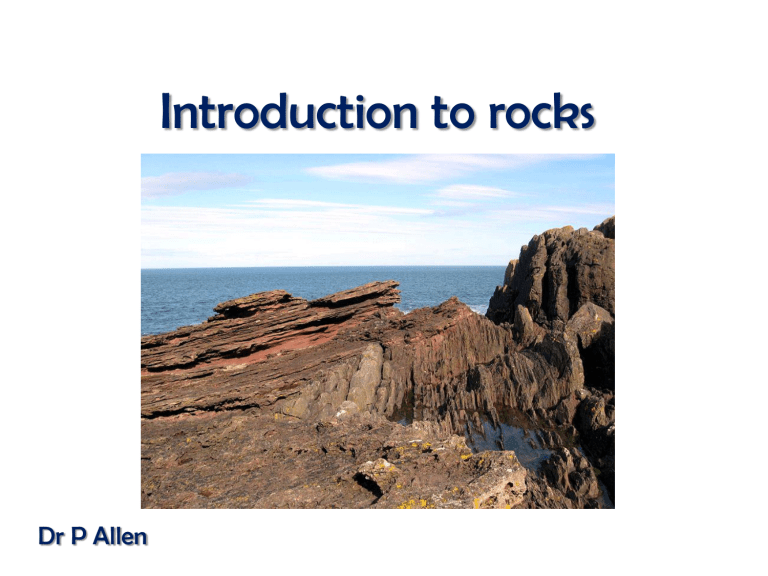Introduction to rocks

Dr P Allen
Introduction to rocks
The Principles of Geologic Science
Fundamental to geology is the principle of Uniformitarianism
Definition?
The scientific law stating that the geological processes taking place in the present operated similarly in the past and can therefore be used to explain past geologic events
James Hutton (1726-1797) supernatural theories were not needed to explain the geologic history
Principle of Uniformitarianism
Uniformitarianism allows us to interpret rocks, however it is in the PRESENT that many geological processes are discovered, observed and analysied:
Application of modern observation to ancient rock = Actualism
The present is the key to the past
The Present is the Key to the Past
Great Phrase but not strictly correct – Why?
Because not all events of the past have been duplicated or observed within the Human time span
Did a asteroid cause the extinction of the Dinosaurs?
Did the impact inject dust into the upper atmosphere to cause a nuclear winter?
Or was it something we have not
Considered?
Because some details remain
Unclear actualism does not apply
Fathers of Modern (Scientific) Geology
James Hutton (1726-1797)
Sir Charles Lyell (1797-1875)
Principles of Geology
After a long debate they changed the view
Of the Scientific community and rejected a theory called
Catastrophism
Both thought the Earth was ever changing BUT retained its basic features
By applying THEIR principles we know this to be untrue!
Mothers of Geology
She sells sea-shells on the sea-shore,
The shells she sells are sea-shells, I'm sure
For if she sells sea-shells on the sea-shore
Then I'm sure she sells sea-shore shells.
Mary Anning (1799-1847)
Mary Anning's first Plesiosaur
Materials and Processes of Geology
ROCK?
Rocks consist of interlocking or bonded grains of matter which are typically composed of minerals
Minerals
Naturally occurring inorganic solid element or compound with a particular chemical composition or range of compositions and a characteristic internal structure
Quartz (Silicon dioxide Si04) most common mineral on the face of the Earth. It is found in nearly every geological environment and is at least a component of almost every rock type
Nature and Origin of Rocks
Basic Rock types -How Many?
Igneous, Sedimentary and Metamorphic
Igneous rocks form when magma crystallizes and solidifies. The melt originates deep within the Earth and are divided into two groups, intrusive or extrusive (volcaneos), depending upon where the molten rock solidifies.
Intrusive formed below surface but eventually exposed at surface
Rock broken down by Weathering – weathered rock is transported to a site and accumulates as sediment
Sedimentary Rocks
Where does sediment accumulate? How does it become solid?
Deserts, rivers, slopes, beaches, seafloors, lakes,
Lithification – the process of sediment becoming solid rock
The grains of sediment become mutually attached by compression of the sediment after burial.
The sediment may be glued together by precipitation of mineral cement from watery solutions that flow through the sediment.
1. Clastic –Sandstone - Conglomerates
2. Biogenic
Sedimentary Rocks (cont)
3. Chemical
Metamorphic Rock
Where does metamorphic rock come from? How does it develop?
Metamorphic rocks form when rocks are subjected to high heat, high pressure, hot, mineral-rich fluids or, more commonly, some combination of these factors
Marble (non foliated)
Gneiss (foliated)
Igneous Rocks
• Extrusive igneous rocks
– Hardens at the Earth’s surface
• Intrusive igneous rocks
– Hardens within the Earth
Rock Cycle
Intrusive relationships
Component relationships
Multiple cycle within the “rock cycle”
Geologic Time Scale
• Developed using
– Biostratigraphy (fossil succession)
– Radioactive decay
• Divided into
– Phanerozoic
– Precambrian/Archean
• Cambrian
– Oldest rocks with conspicuous fossils







